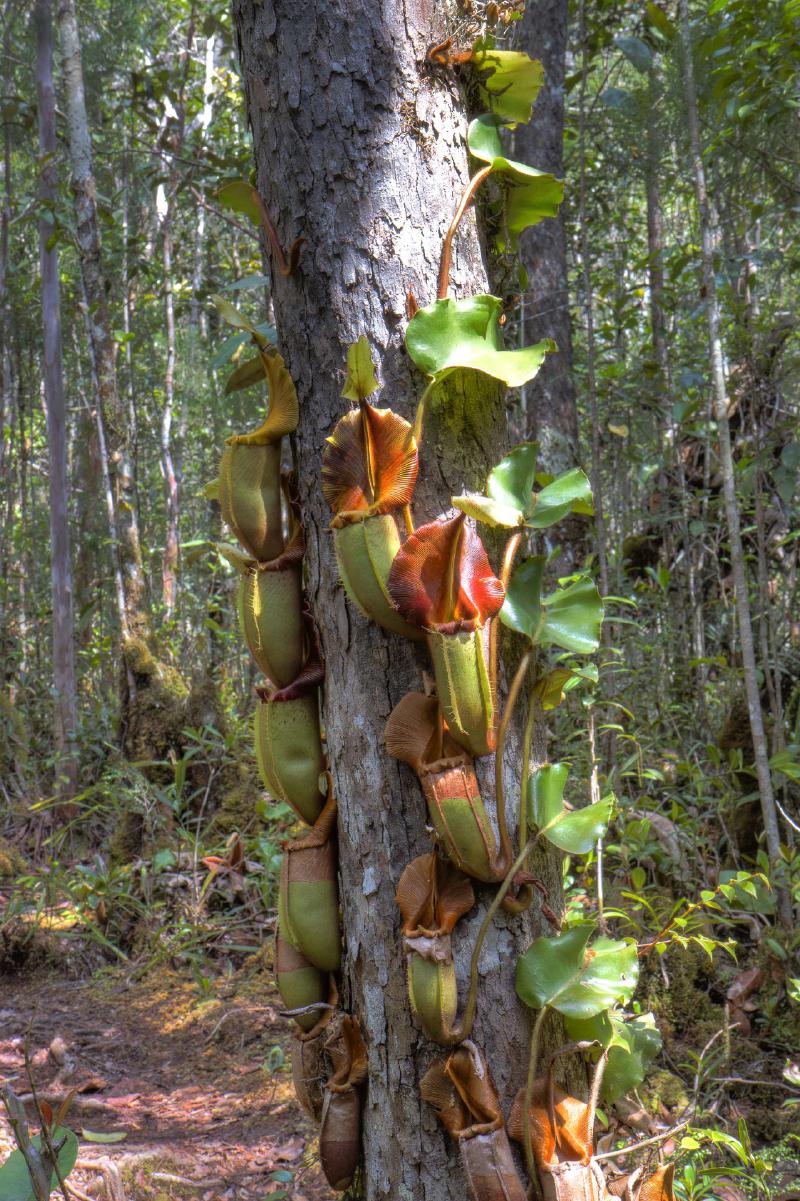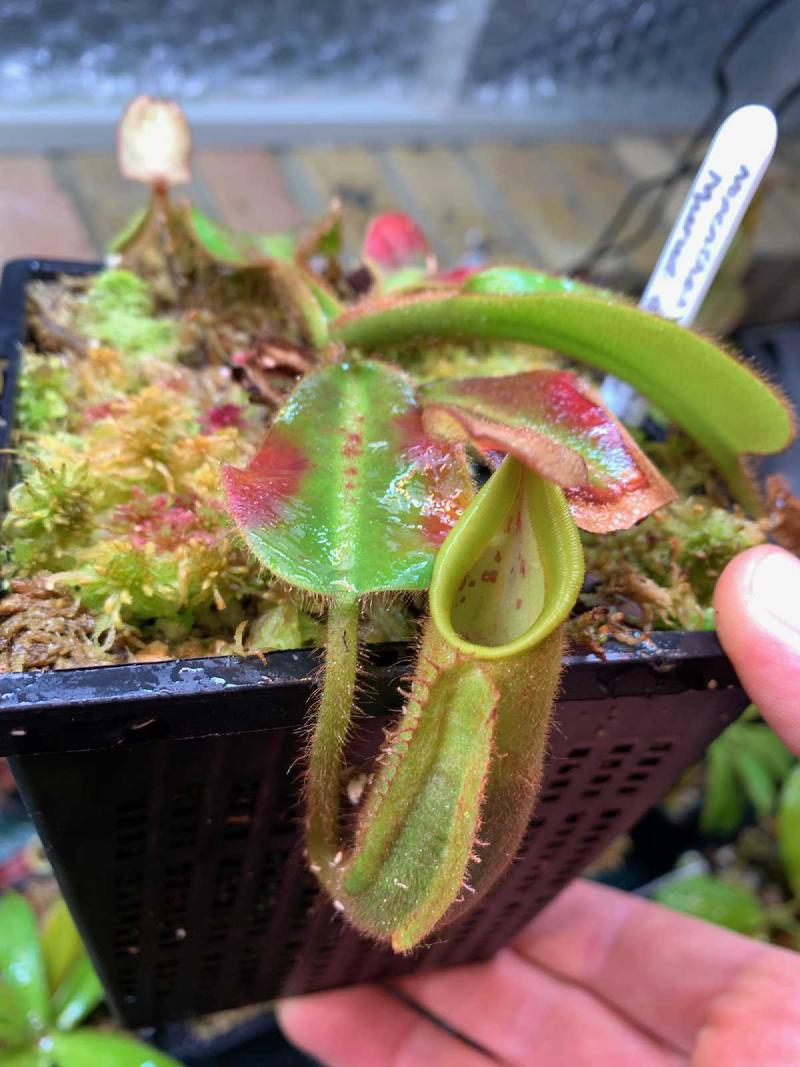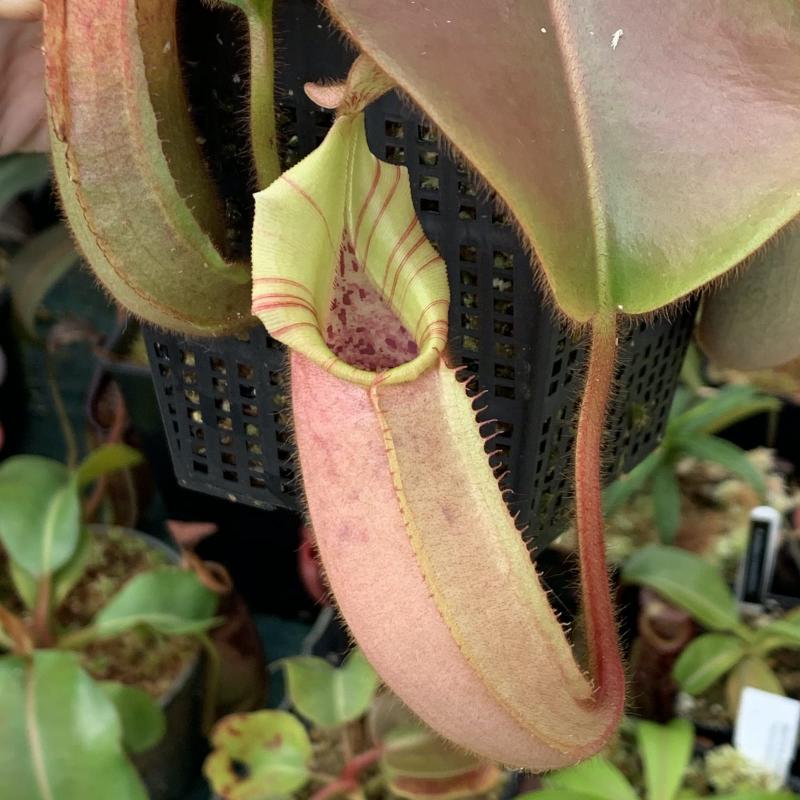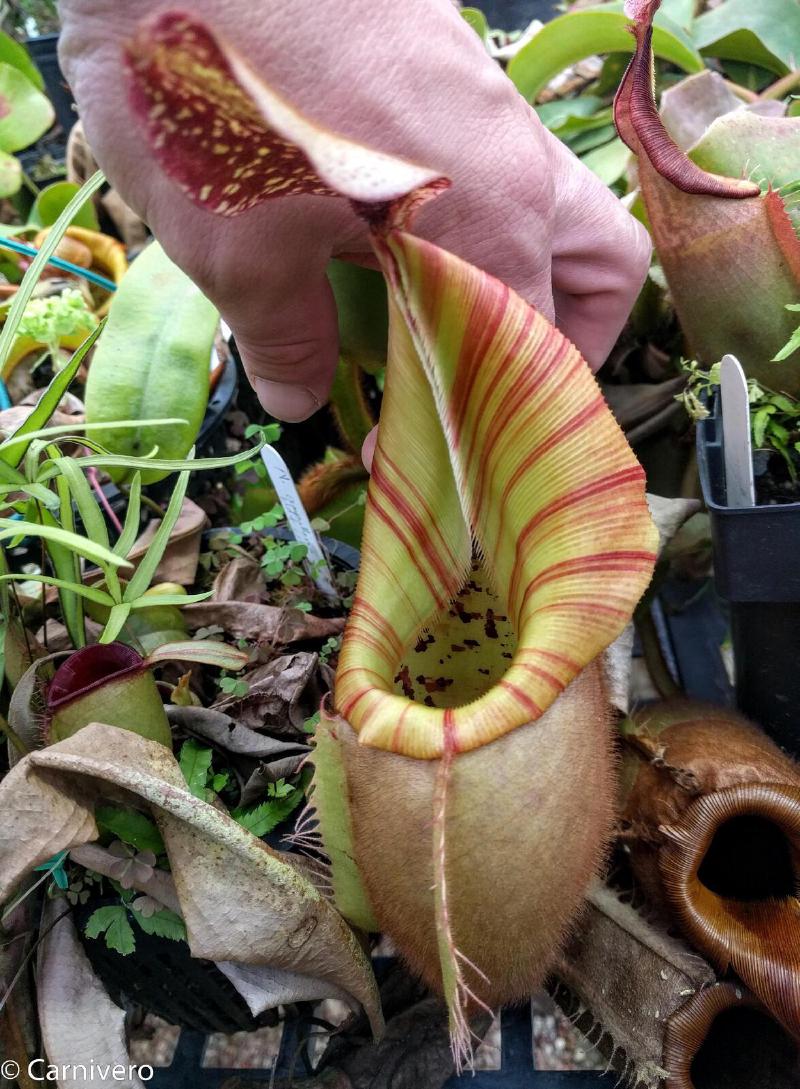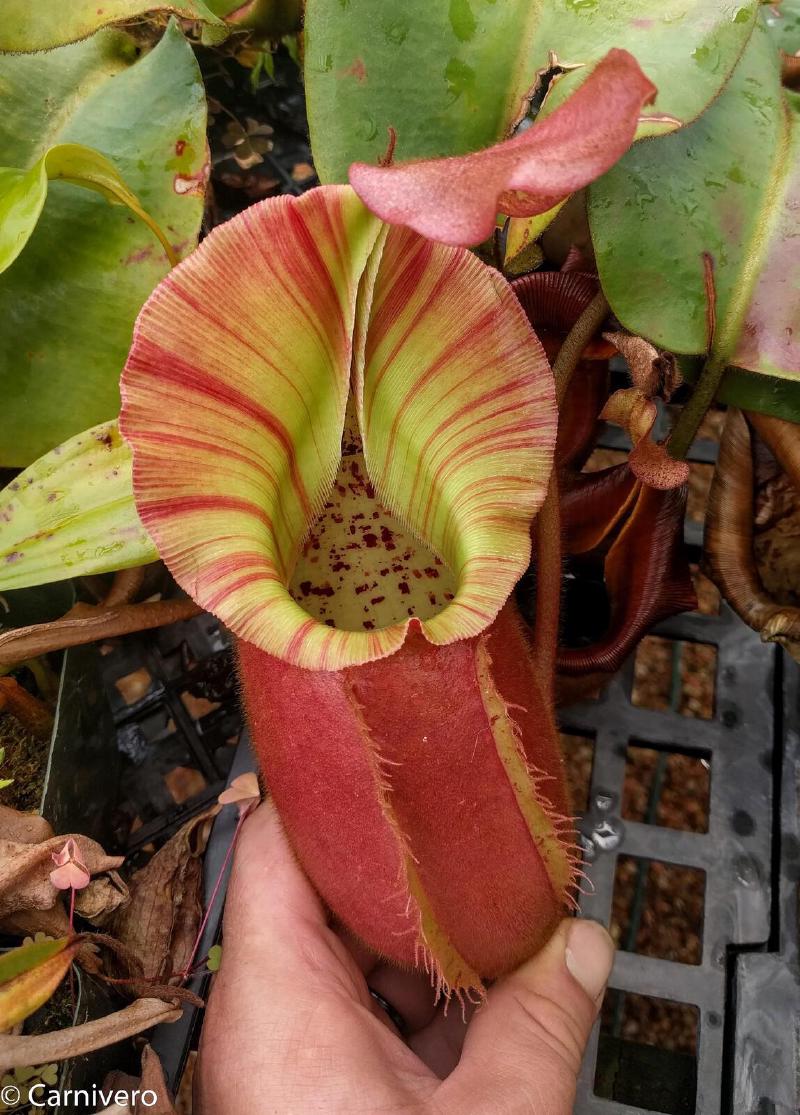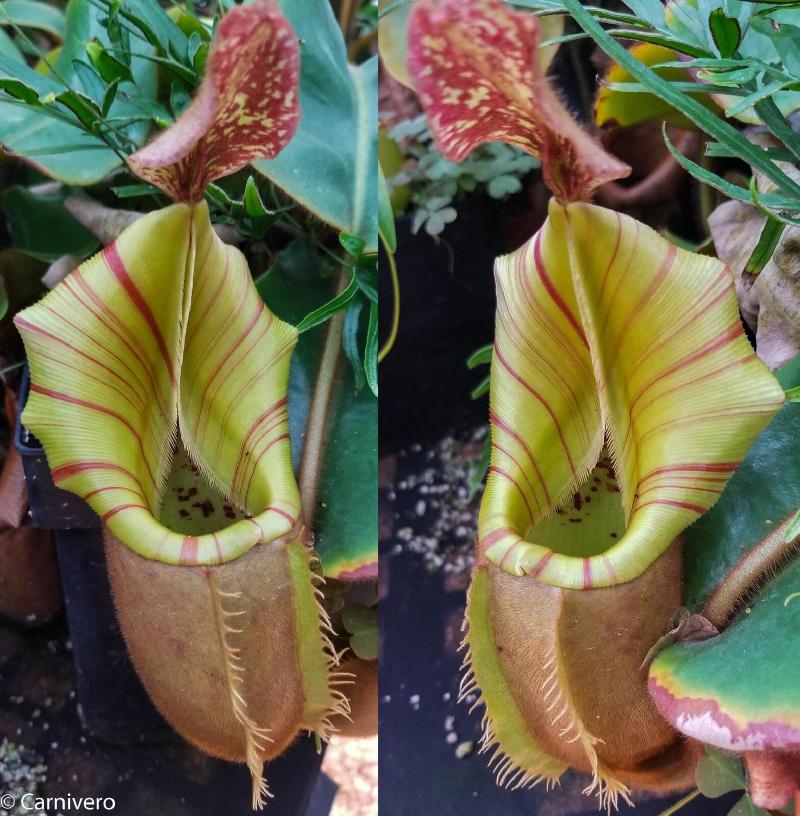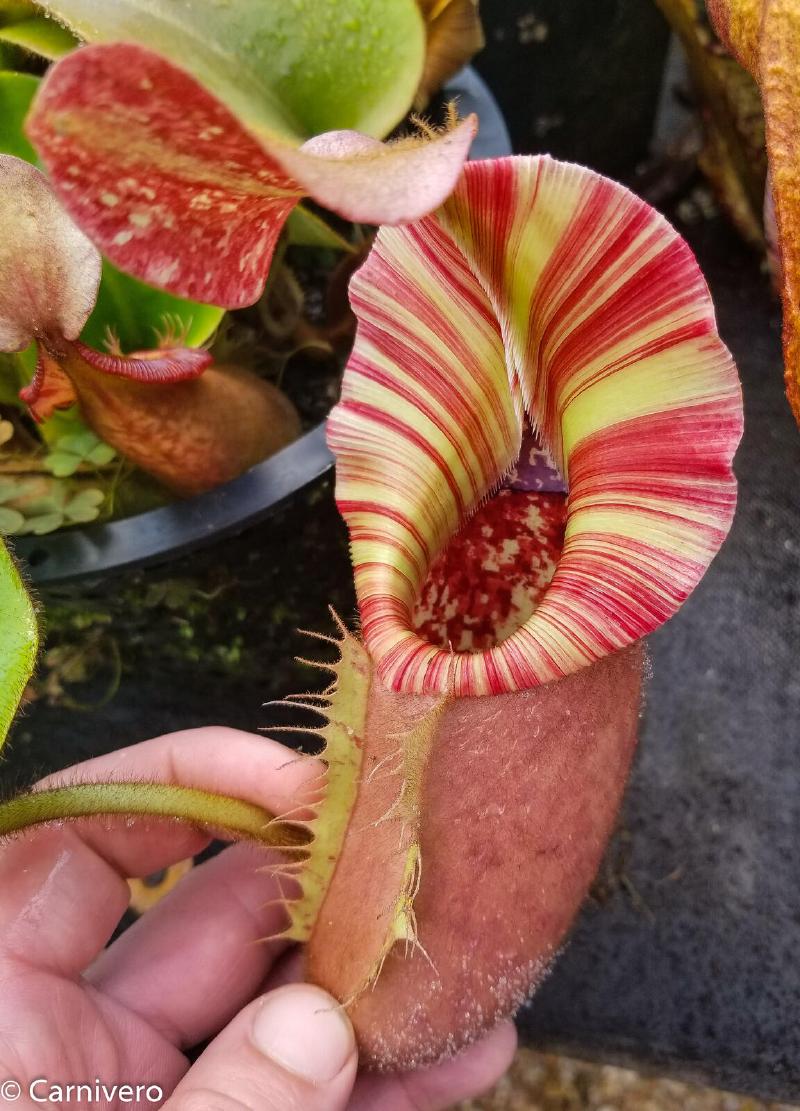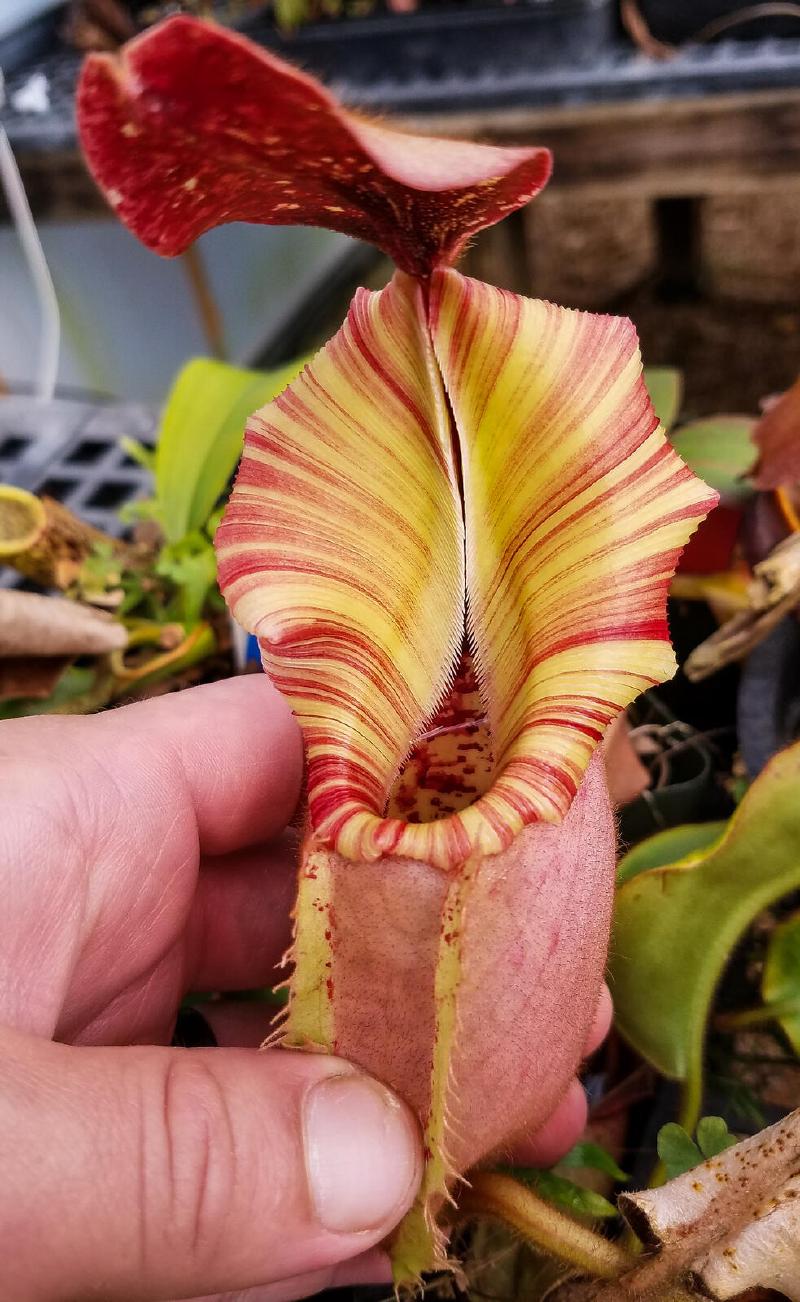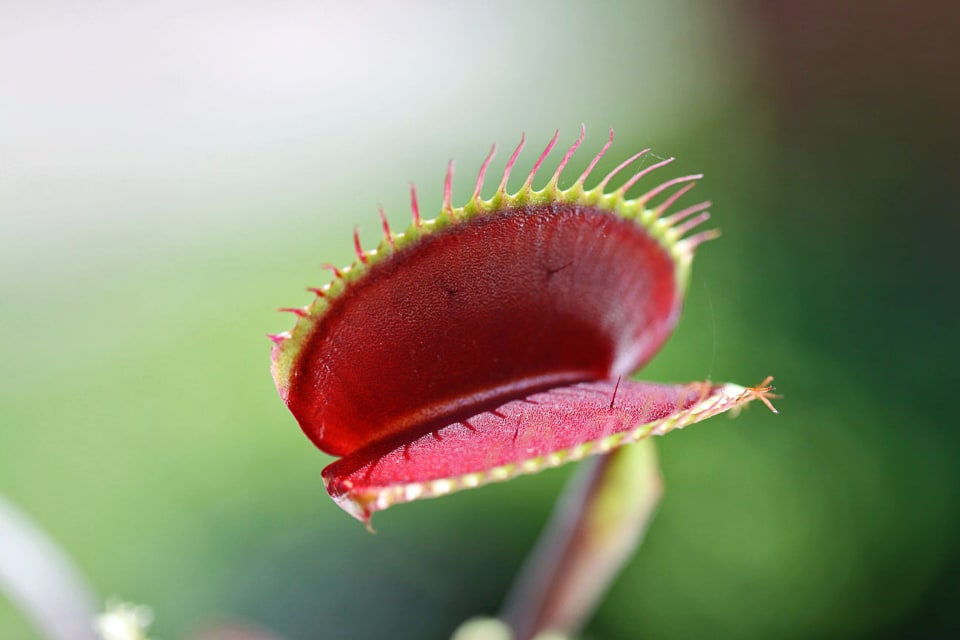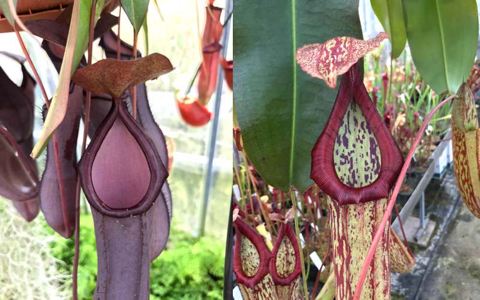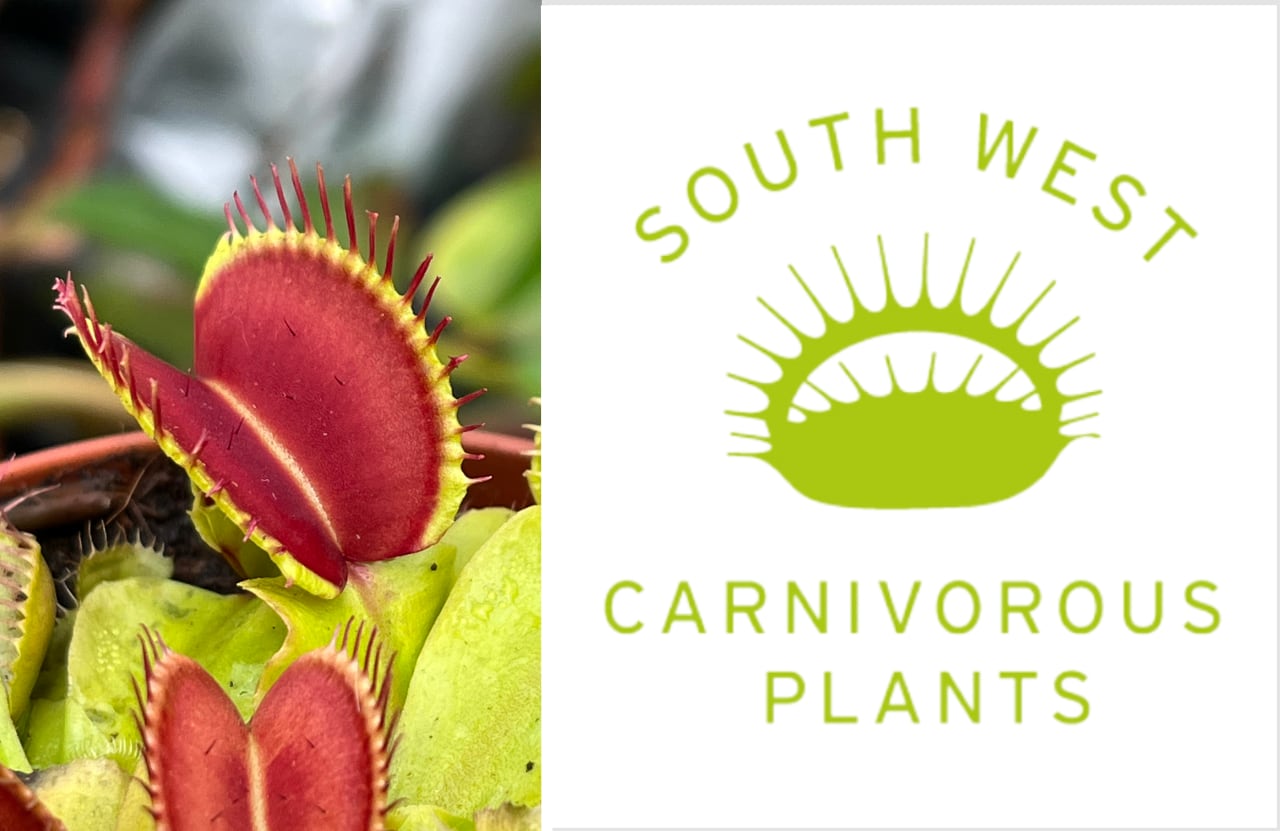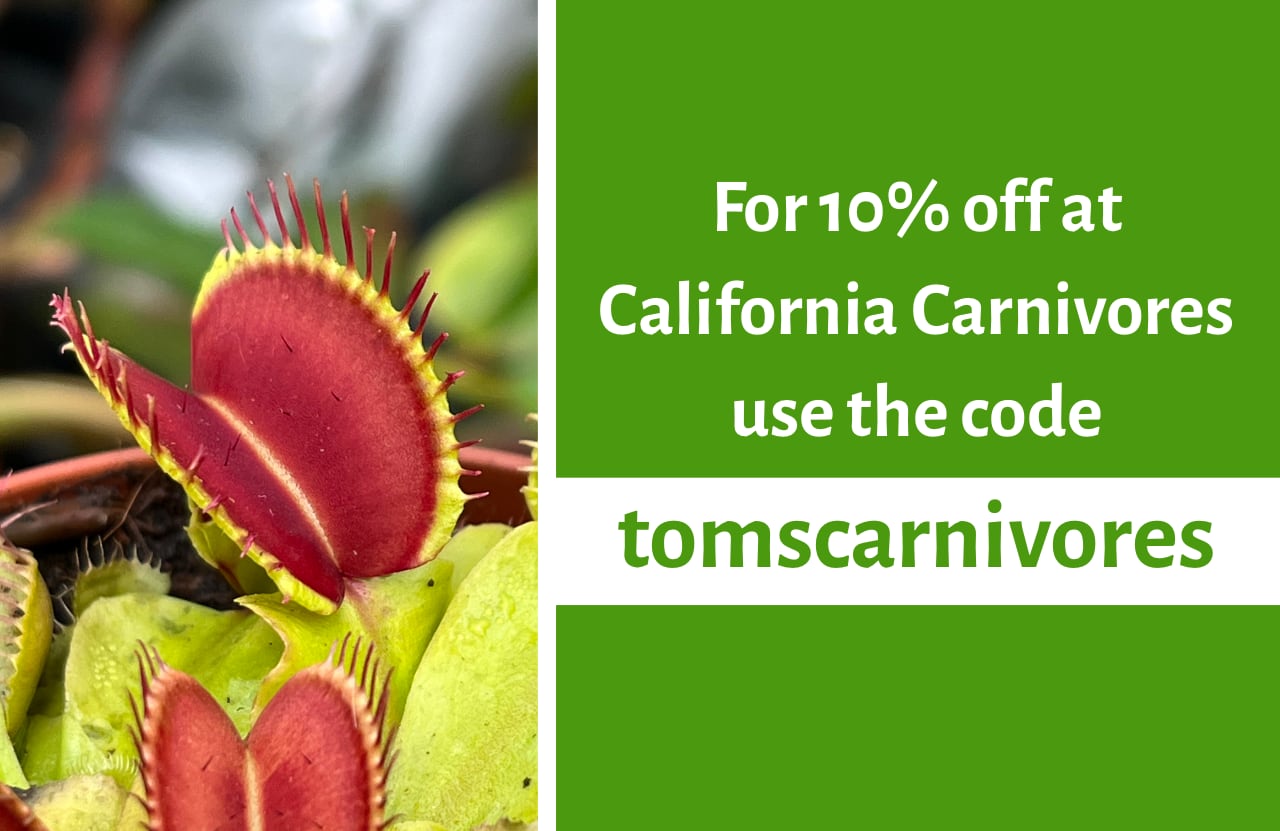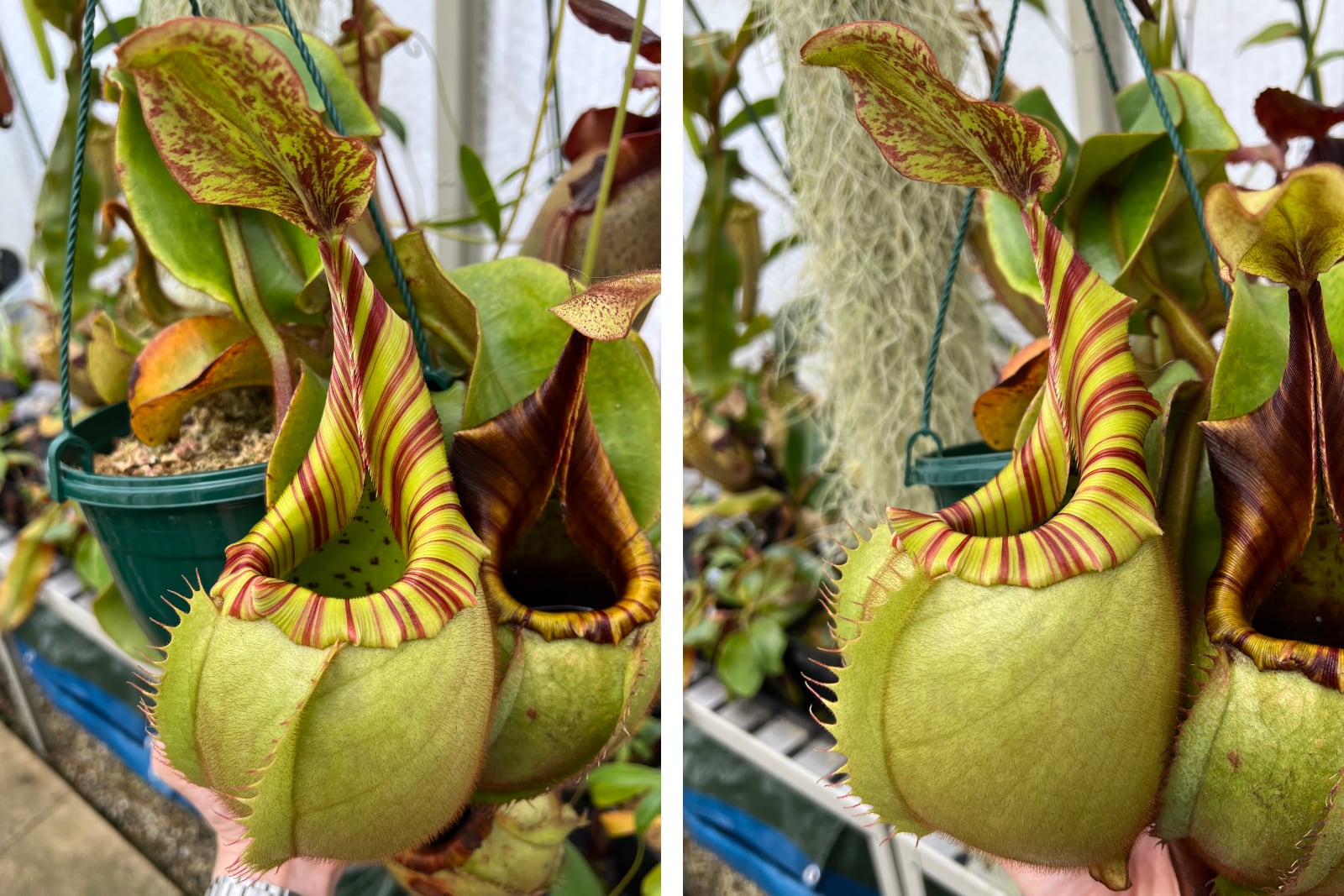
Species Showcase: Nepenthes veitchii
Published 25 February 2020, updated
When I first started collecting Nepenthes, I can’t say that N. veitchii was high on my list.
I was about 12, and like many other burgeoning hobbyists in the early 2000s I consumed everything I find could online about Nepenthes. I was immediately enthralled by the monstrosity of N. lowii and the enormity of N. rajah. Naturally those species still hold huge appeal, but as my collection has grown I’ve found that the squat, hairy, colourful little pitchers of N. veitchii fascinate me as much as any others in the genus.
And so for my first species showcase I’ll be looking at Veitch’s pitcher plant, so named to honour renowned Victorian horticulturalist James Veitch. As with Francis’s look at Nepenthes peltata in December, this article is intended as a general guide for enthusiasts. I’ve collaborated with several other veitchii-addicts to get input on forms and clones which I myself don’t yet grow. Enjoy!
Contents
1. Natural range & habitat
Nepenthes veitchii is native to Borneo. It can be found widely across the northern half of the island, particularly Sabah, Sarawak, and Central Kalimantan, and has a broad altitudinal distribution: 0 to 1600m. As such, the various forms of N. veitchii which have entered the horticultural trade may be considered lowland, intermediate, or - just barely - highland plants, depending on the locale from which they originate. As we shall see, this wide range makes N. veitchii a particularly adaptable plant.
“This is one of the finest and rarest of pitcher-plants […] Some of the specimens I got measured quite ten inches in length. It is also a perfect trap to entice insects into its interior, attracting them from a distance by its bright colours.”
Broadly speaking there are three main ’types’ of N. veitchii, and these are distinct in both their growth habits and pitcher morphology. First is the lowland form which grows as an epiphyte, clambering over the branches of large trees. These plants have elongated leaves and tall, cylindrical pitchers that can be yellow, green, or orange, and a peristome that often darkens with age to a deep gold or reddish-brown colour. As with all forms of N. veitchii, the stem, leaves, and pitchers are covered with coarse rusty-brown hairs.
The populations of N. veitchii which occur at higher elevations tend grow on the ground, and these terrestrial plants exhibit one of two growth habits: climbing or scrambling. The climbing form occurs most famously in the Maliau Basin, where N. veitchii grows vertically up trees by wrapping its leaves and tendrils around their trunks. These plants can reach heights of over 10 meters as they ascend into the canopy, as can be seen in the stunning photography of Drew Martinez below. I’ve reproduced them here with Drew’s permission - you can see his fantastic original blog post here.
Finally, there are the terrestrial forms which prefer to remain prostrate on the ground. These plants grow a scrambling stem which creeps along the forest floor, and produce squat, tubby pitchers which are more globose than other forms of the species. Leaves tend to be shorter and rounder than the lowland forms. The most famous population of highland scrambling N. veitchii occurs near the town of Bareo, in Sarawak, but many specialist nurseries have recently started selling plants from the Pa Umor area, a village several kilometers east of Bario. The plants from these highland localities are highly variable in coloration, and some particularly coveted forms have wide, dramatically-flared peristomes striped with red and yellow.
In the wild, Nepenthes veitchii forms natural hybrids with N. albomarginata, N. chaniana, N. fusca, N. mollis (formerly N. hurrelliana), N. lowii, N. stenophylla, and possibly N. faizaliana.
To learn more about the natural habitat of N. veitchii, or for a scientific perspective on the botany or taxonomy of tropical pitcher plants in general, I highly recommend Stewart McPherson’s Pitcher Plants of the Old World (volume one covers N. veitchii, but volume two and the follow-up New Nepenthes are both essential reading too).
Note: Hate that I feel the need to say this, but please remember that plants should never be taken from their natural habitats. Poaching poses a very real threat to the continued existence of many plant species, and several Nepenthes have already been driven to the brink of extinction by poachers. Do not buy poached plants, and report poachers to the relevant authorities.
2. Nepenthes veitchii cultivation
Remembering that N. veitchii has a wide natural range, it’s not surprising that the species is often adaptable and robust in cultivation. While it’s always important to learn which form of a species you are growing - including whether it’s of highland or lowland origin - the majority of N. veitchii available from carnivorous plant nurseries are easy to care for in typical intermediate conditions.
Wherever you chose to grow it, N. veitchii is a species which rewards patience! It’s a slow grower, particularly in its first few years. Seedlings can seem to take an age to properly get going and are often rather nondescript when they’re young. Desirable traits such as peristome striping, vibrant colouration, and a squat pitcher shape don’t become apparent until the plant starts to reach maturity. This is something I’ve come to enjoy about the species; it can be quite rewarding to watch a small and plain-looking plant transform into a beautiful specimen.
I grow all my N. veitchii in my highland greenhouse, and before that in my intermediate terrariums. I’ve found they tend to be happiest with days of around 24 - 28°C (78 - 82°F) and nights of 14 - 18°C (59 - 64°F), and so do best for me during the warmer times of year here in the UK.
While they like humidity to be above 70%, I’ve found that N. veitchii - like many other hirsute (hairy) species - can often be acclimated to lower-humidity environments such as on windowsills. The deadly combination that you’ll want to avoid with this species is cold and damp - I believe this is why N. veitchii has a reputation for hating British winters. Keep them in the warmer part of your grow space, don’t let them get soggy, and they should fare well until the warmer time of year.
In terms of potting mix, I’ve found that N. veitchii likes to be kept slightly on the drier side (although that might simply be a reflection of how little they grow - and therefore how little water they need - during our cold winters). As such, I grow them in a coarse mixture - I still use long fibered sphagnum moss as the main ingredient, but add lots of perlite, kanuma, and Orchiata pine bark for a ‘chunky’ soil. Once they’re about 10cm across I start them in net pots (often sold as ‘pond baskets’ here in the UK). I usually let the top of the moss start to dry before watering again.
N. veitchii is more tolerant of shade than many other highland species, but bright light certainly brings out the best colouration in the pitchers (which can last for almost 6 months in good conditions). I grow under natural light and supplement with LEDs during the short winter days. It doesn’t take a huge amount of light to give the leaves a slight bronze-coloured tint.
For more general advice on cultivation, check out my Complete Guide to Tropical Pitcher Plants. To calculate the requirements of hybrids involving Nepenthes veitchii, head over to my Nepenthes Interactive Guide.
3. Commonly-available forms
Unlike many other Nepenthes species, there is a diverse range of horticulturally-produced N. veitchii available in cultivation. Whereas some other desirable species remain available only as a handful of selected clones or germinated from wild-collected seed, hundreds of N. veitchii have been grown to maturity, flowered, and crossed by nurseries all over the world to produce an exciting variety of progeny. New forms are constantly making their way to market.
Most - but by no means all - of the Nepenthes veitchii which you’ll encounter in cultivation are of intermediate or highland origin. The varieties with particularly squat pitchers or candy-striped peristomes are considered to be among the most desirable plants in the hobby, and mature plants can fetch a considerable price.
Below I’ve provided a summary of some popular forms you’re likely to encounter in cultivation, but this list is by no means comprehensive!
Exotica Plants
Based in Queensland Australia, Exotica Plants (EP) are world-renowned for their Nepenthes selective breeding. While they are most famous for their hybrids (particularly their complex ones), they have released horticultural greges of many species including N. veitchii. Sadly I’ve yet to get my hands on any of EP’s N. veitchii forms, but Mike Fallen (@veitchii_man13 on Instagram, also check out Mike’s blog here) was kind enough to share a few photos and comments on each.
Nepenthes veitchii (k): First released in around 2004, this was one of the first horticulturally-produced forms of N. veitchii using striped parent plants. As far as I’ve been able to discover, the exact parentage of this grex has never been revealed. The majority of (k) seedlings have reddish pitchers and striped peristomes but in terms of shape are not as squat as some of EP’s later releases of the species. Many plants from this release have been used in Nepenthes breeding around the world.
Mike Fallen: “These are exceptional plants and most I’ve seen are absolutely gorgeous. I grow 3 (k) specimens. These aren’t quite as squat as the (m) grex but some still get quite tubby as they mature.”
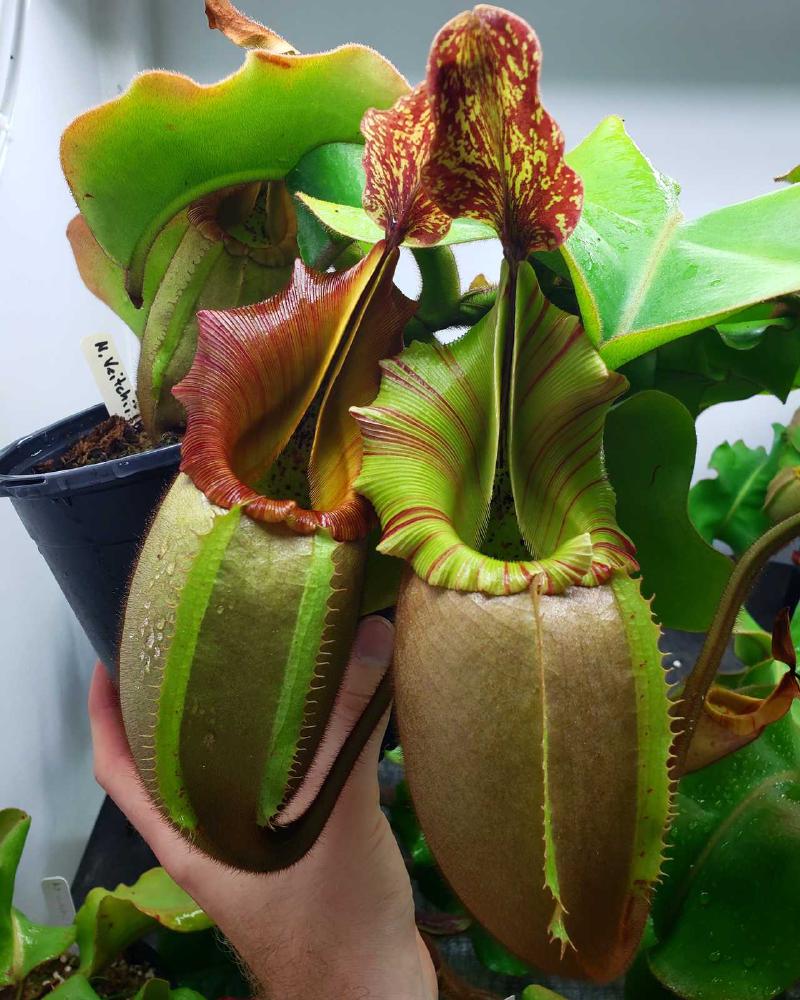 Nepenthes veitchii (k), an Exotica Plants grex, grown by Mike Fallen.
Nepenthes veitchii (k), an Exotica Plants grex, grown by Mike Fallen.
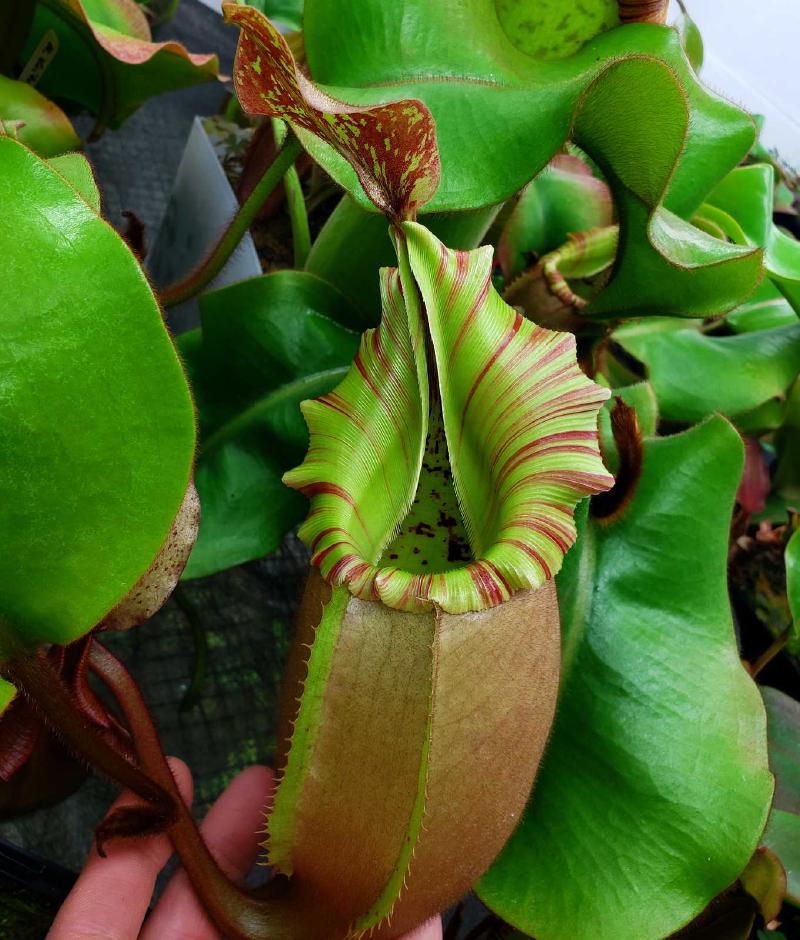 Nepenthes veitchii (k), an Exotica Plants grex, grown by Mike Fallen.
Nepenthes veitchii (k), an Exotica Plants grex, grown by Mike Fallen.
Nepenthes veitchii (m): Released around 2013, this is EP’s most recent N. veitchii grex and by many accounts it is spectacular. Many of the (m) offspring are squatter than the (k) plants while exhibiting excellent colouration.
Mike Fallen: “I grow 5 specimens from this grex. These are my current favorite N. veitchii. Most of these are very squat with a huge variety in coloration. Obviously the striped specimens from this grex are highly coveted by collectors.”
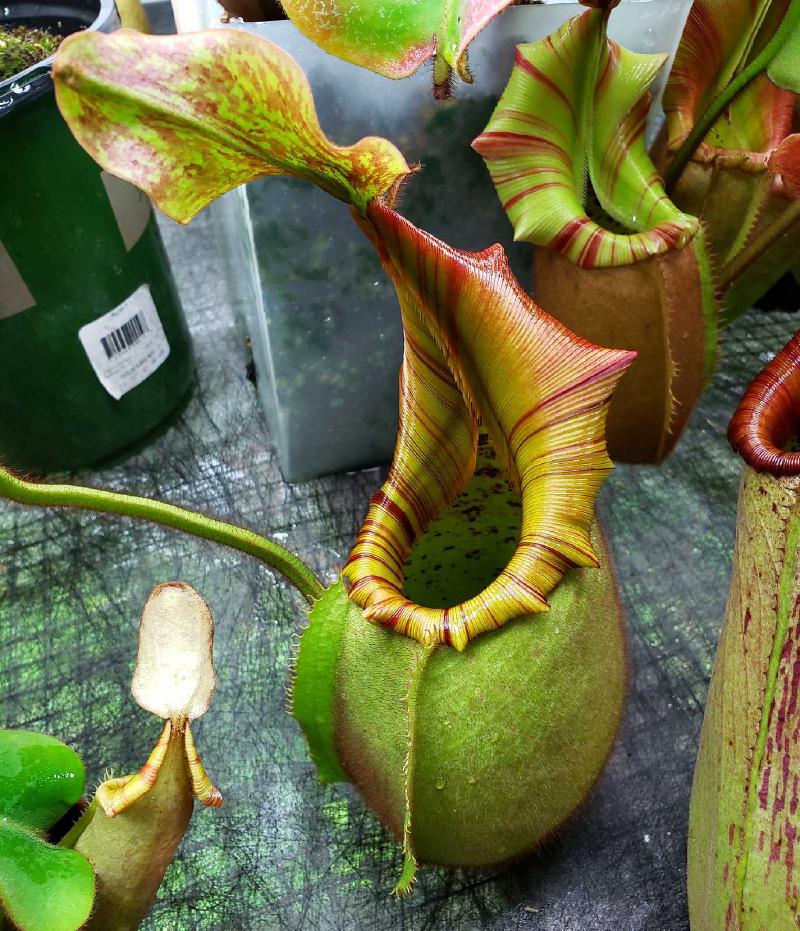 Nepenthes veitchii (m), an Exotica Plants grex, grown by Mike Fallen.
Nepenthes veitchii (m), an Exotica Plants grex, grown by Mike Fallen.
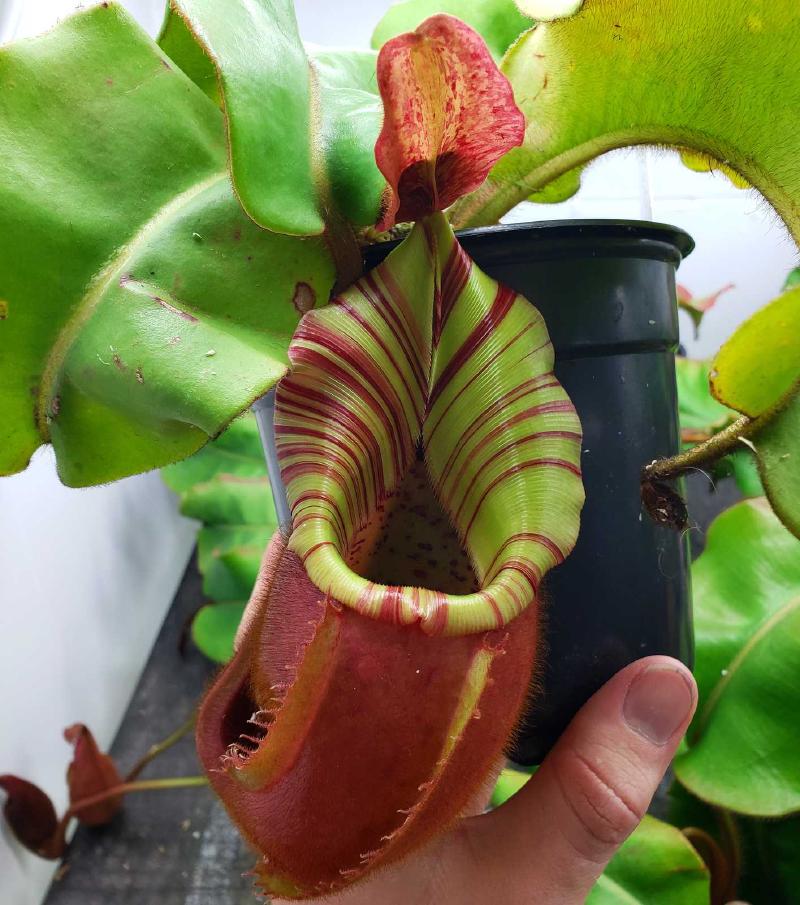 Nepenthes veitchii (m), an Exotica Plants grex, grown by Mike Fallen.
Nepenthes veitchii (m), an Exotica Plants grex, grown by Mike Fallen.
Christian Klein
Christian is based in Germany and has a fantastic collection of breeding Nepenthes veitchii. Be sure to check out my article about my visit to Chris’s nursery for more shots of the parent plants and offspring.
N. veitchii ‘Murud Striped’ x ‘Candy’: This is a seed-grown cross which Christian has done several times, so some plants in cultivation have already grown to maturation. I’ve collected a few of these, and it’s a fantastic and variable cross. Many have a lovely red pitcher colour and striped peristome, and are more elongated than squat. Below are my photos of the parent plants (the seed parent ‘Murud Striped’ on the left and Chris’s male ‘Candy’ on the right), followed by a photo of a mature specimen grown by Floravitro.
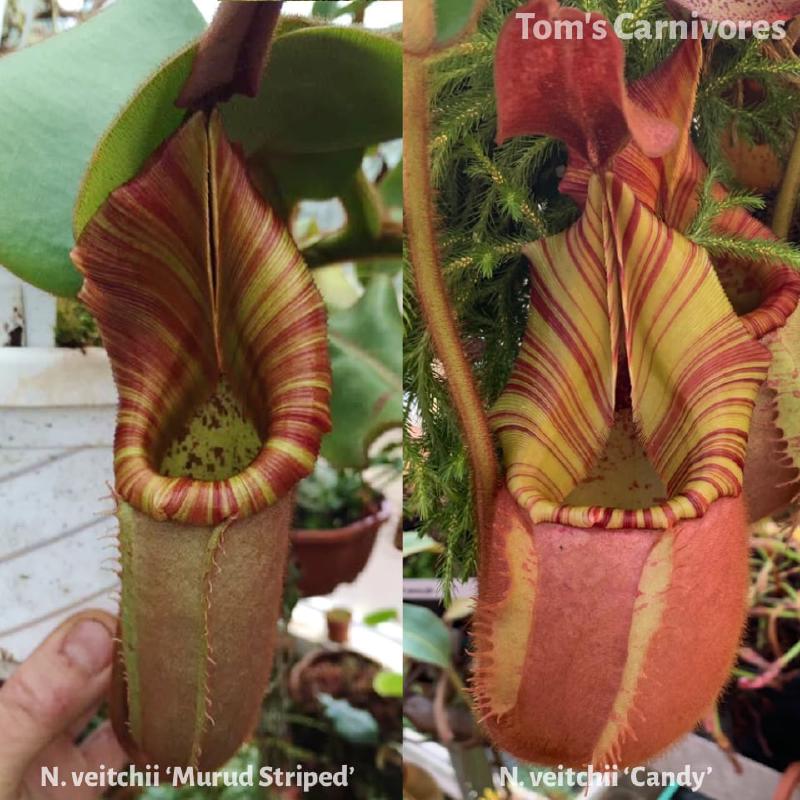 The parent plants of Nepenthes veitchii 'Murud Striped' x 'Candy', photographed by me in Chris Klein's greenhouse.
The parent plants of Nepenthes veitchii 'Murud Striped' x 'Candy', photographed by me in Chris Klein's greenhouse.
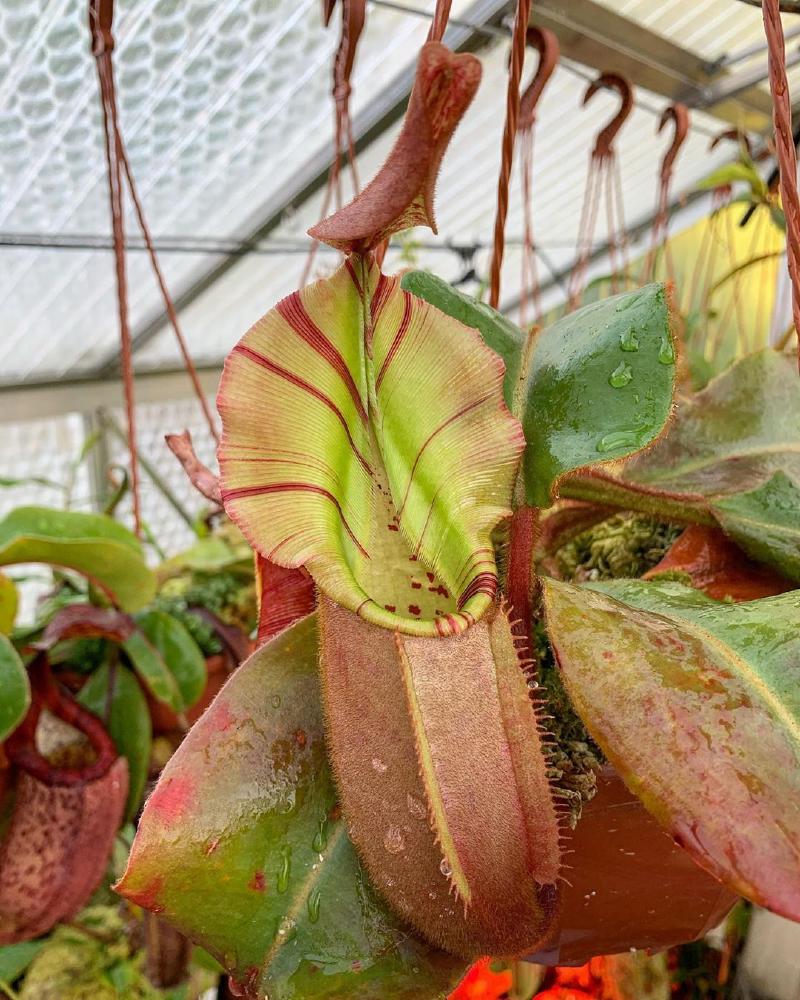 Nepenthes veitchii 'Murud Striped' x 'Candy', grown by Floravitro.
Nepenthes veitchii 'Murud Striped' x 'Candy', grown by Floravitro.
N. veitchii ‘Candy’ x ‘Candy’: The same male parent as the previous cross, but with Chris’s Candy-striped female as the mother plant. The pitcher shape in this cross is variable while the colour is - from what I’ve seen - uniformly outstanding, as can be seen from my photo of a larger plant from this grex below.
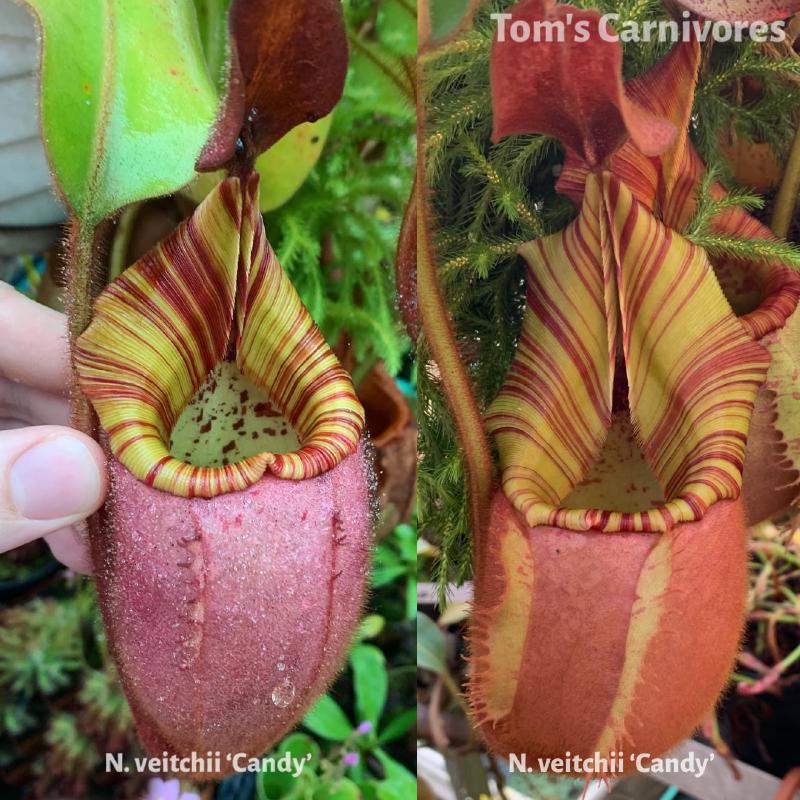 The parent plants of Nepenthes veitchii 'Candy' x 'Candy', photographed by me in Chris Klein's greenhouse.
The parent plants of Nepenthes veitchii 'Candy' x 'Candy', photographed by me in Chris Klein's greenhouse.
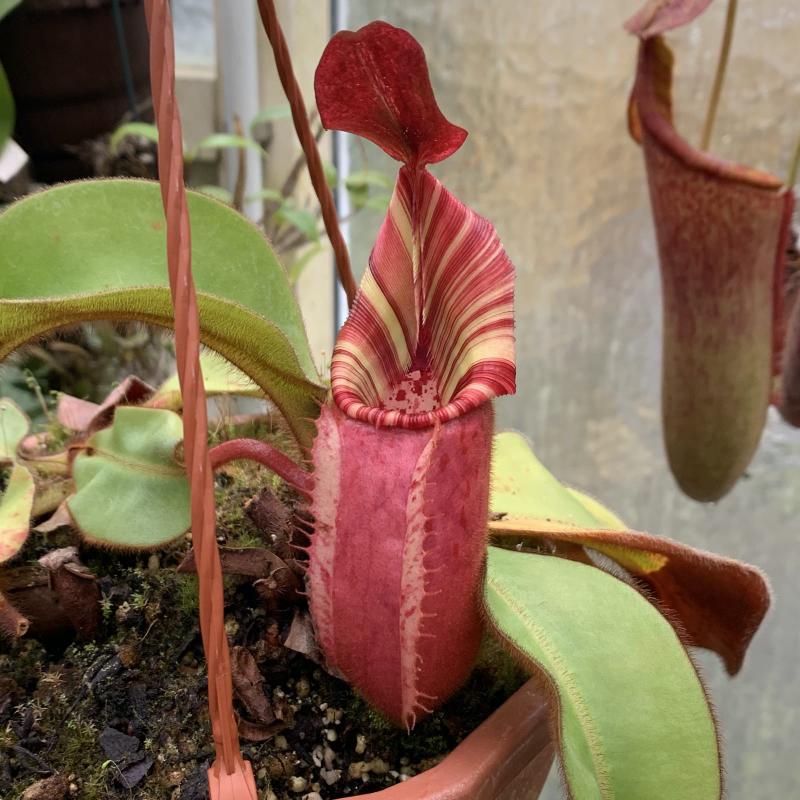 Nepenthes veitchii 'Candy' x 'Candy', large specimen.
Nepenthes veitchii 'Candy' x 'Candy', large specimen.
N. veitchii ‘Candy’ x ‘Yamada’: The same striped mother plant as the previous grex, but this time crossed with a magnificent and huge squat male from Shinya Yamada in Japan. This is a recent cross and so only very young plants are available, but so far it looks promising - some really nice pitcher shape, even in little plants.
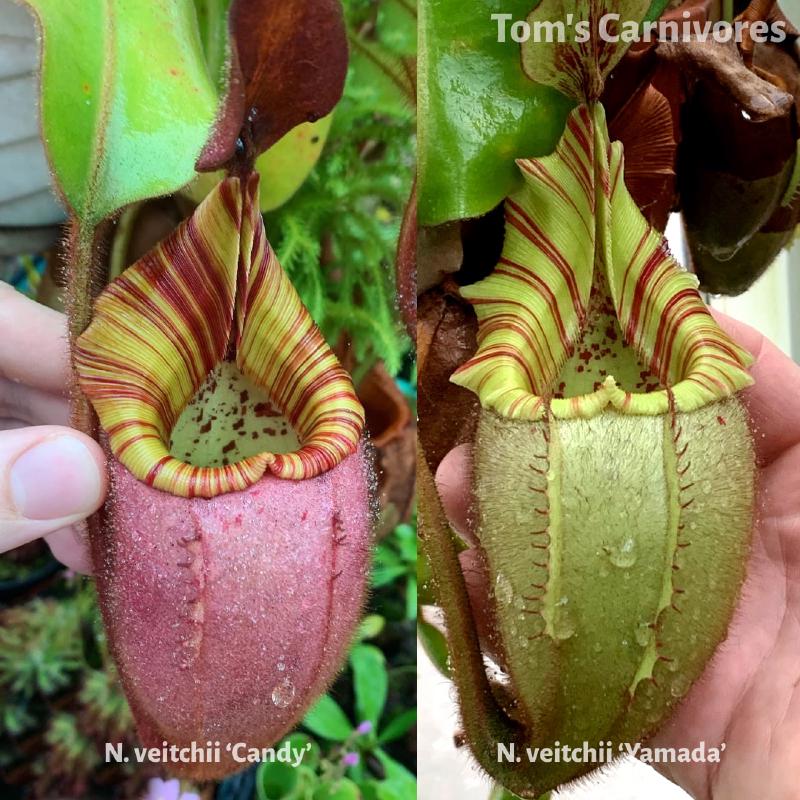 The parent plants of Nepenthes veitchii 'Candy' x 'Yamada', photographed by me in Chris Klein's greenhouse.
The parent plants of Nepenthes veitchii 'Candy' x 'Yamada', photographed by me in Chris Klein's greenhouse.
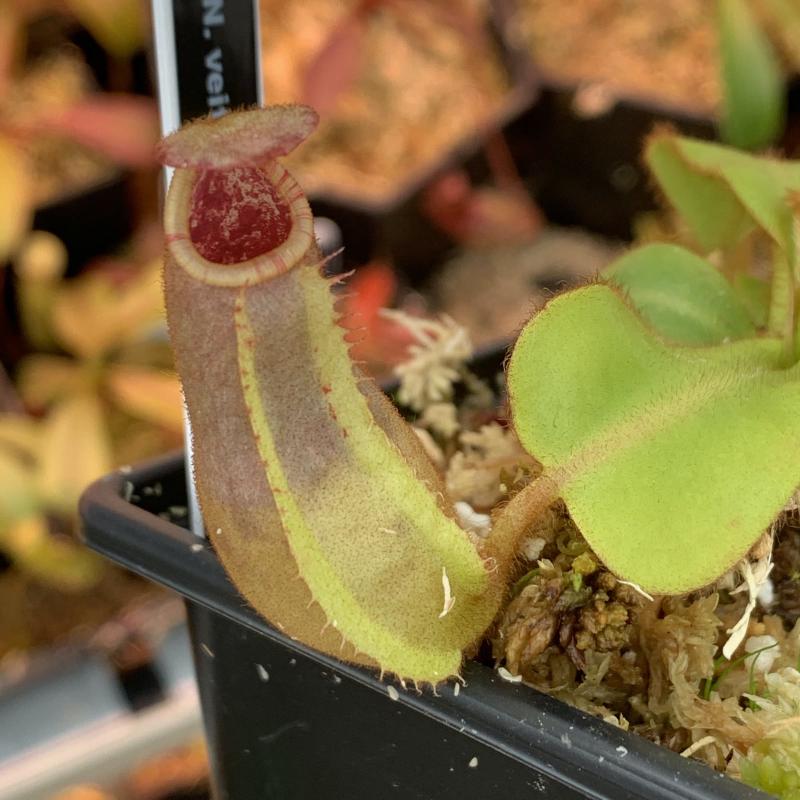 Nepenthes veitchii 'Candy' x 'Yamada', young seedlings - note the striping already becoming visible!
Nepenthes veitchii 'Candy' x 'Yamada', young seedlings - note the striping already becoming visible!
Carnivero
Owned and operated by Drew Martinez in Texas, the Carnivero nursery opened its doors in 2018 and already boasts an extremely impressive breeding program. You can read about Carnivero’s remarkable journey and discover details of Drew’s Nepenthes breeding plans in my feature on Carnivero. Be sure to follow Drew on Instagram too (@carniveroatx).
Nepenthes veitchii Big Mama x Pink Candy Cane: “A horticultural grex we’ve done twice at Carnivero, once in 2015 and again in 2018. Big Mama is a striped (k) form. Pink Candy Cane was purchased as a veitchii (h) and actually did not show striping until it was 8 inches across. I’ve heard that the (k) and (h) veitchii had the same parentage but were separated between the striped and unstriped variants leaving EP. The offspring from this cross have shown a range of variants but the majority inherit the pink body from the father and striping. The form seems to be moderately squat like the parents as well with some individuals being extremely squat.”
Nepenthes veitchii #5 x Pink Candy Cane: “A horticultural grex done in 2019. #5 is a striped (k) form that had the squattest shape and widest peristome from a large batch of individuals, and Pink Candy Cane is an outstanding breeder described above. The offspring from this cross are still young but so far we’ve noticed a lot of pinks and reds. I expect them to inherit the outstanding characteristics from both parents.”
Nepenthes veitchii #5 x The Wave: “A horticultural grex done in 2019. #5 is a striped (k) form described above. “The Wave” is an exceptionally beautiful seed raised veitchii from the Kelabit Highlands. It has a pink pitcher body and extremely wide, striped peristome reminiscent of “The Wave” monument in Arizona. The offspring from this cross are still young but so far I’ve noticed a lot of pinks and reds. “The Wave” tends to pass on its peristome color to its offspring even at an early age.”
Nepenthes veitchii Psychedelic x Pink Candy Cane: “Nepenthes veitchii “Psychedelic” is one of the most outstanding clones in the collection. It is a seed raised plant and has a squat shape and elaborately flared peristome which is as large as the pink pitcher body. As the peristome ages, it exhibits a sunburst coloration. Pink Candy Cane is an outstanding breeder described above. The combination of these two give me really high hopes for the offspring here that were created in 2018 and will soon be released.”
Other popular forms
Borneo Exotics’ ‘Bareo highland’ releases: This is a great cross of two highland Bario forms of N. veitchii, both of which have red striped peristomes. The offspring were made available as BE-3734, a release which contains a very large number of unique clones out of tissue culture. These assorted clones are highly variable in colour and pitcher shape; my favourite of my two plants is shown below.
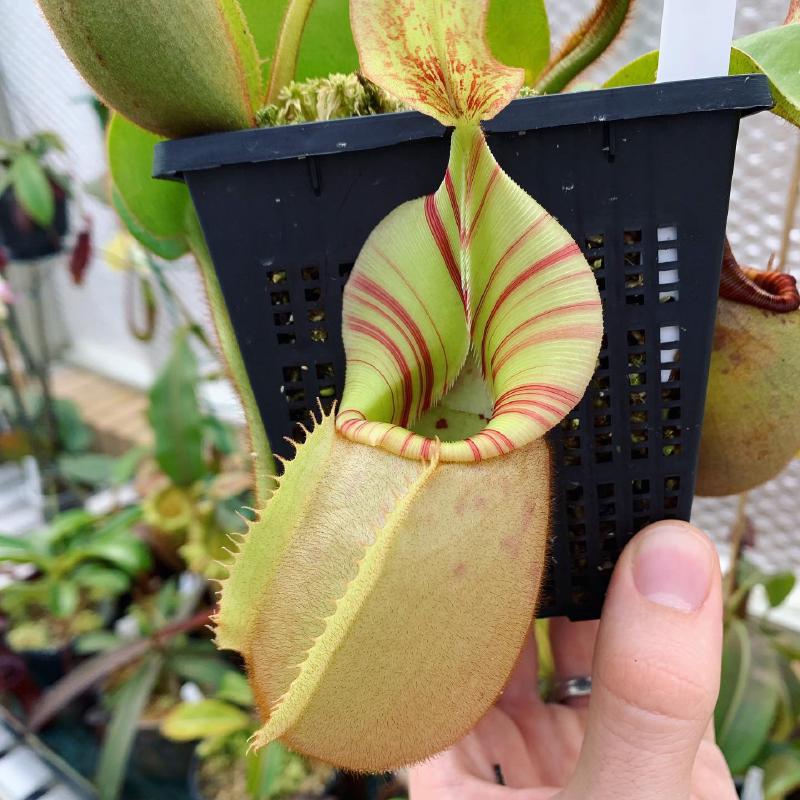 Nepenthes veitchii, from Borneo Exotics' Bareo highland release BE-3734. Lots of variation in this release, but this particular plant has a fantastically striped peristome.
Nepenthes veitchii, from Borneo Exotics' Bareo highland release BE-3734. Lots of variation in this release, but this particular plant has a fantastically striped peristome.
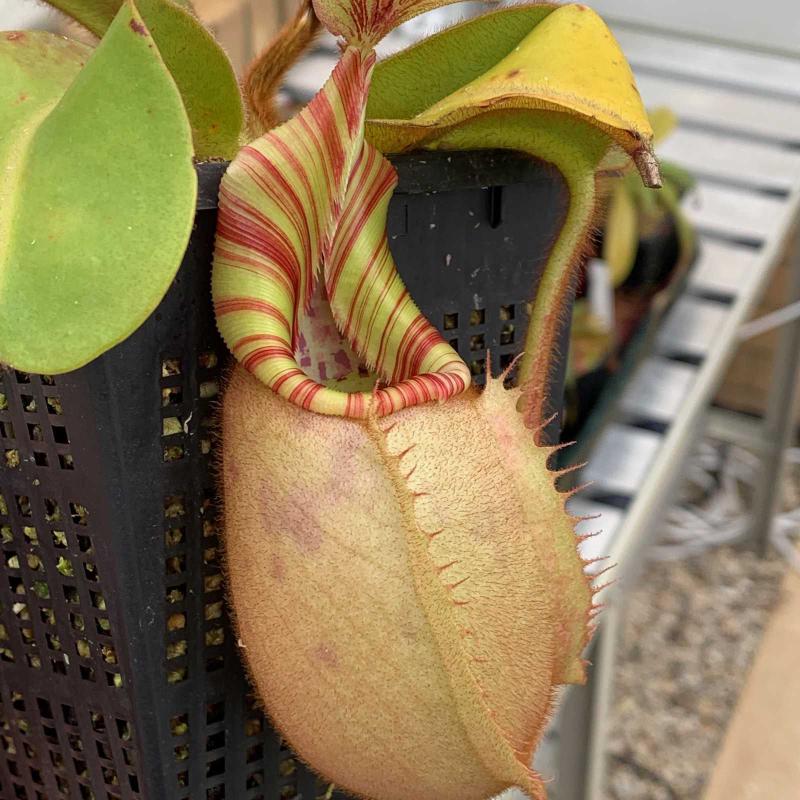 Nepenthes veitchii, from Borneo Exotics' Bareo highland release BE-3734. Lots of variation in this release, but this particular plant has a fantastically striped peristome.
Nepenthes veitchii, from Borneo Exotics' Bareo highland release BE-3734. Lots of variation in this release, but this particular plant has a fantastically striped peristome.
Andreas Wistuba ‘Batu Lawi’. An intermediate/highland form available as a single clone originating from Batu Lawi, is a twin-peaked mountain in the Kelabit Highlands. This plant has yellow-orange pitchers, a yellow peristome, and lovely round leaves, as can be seen in photos of a mature plant grown by Francis Bauzon.
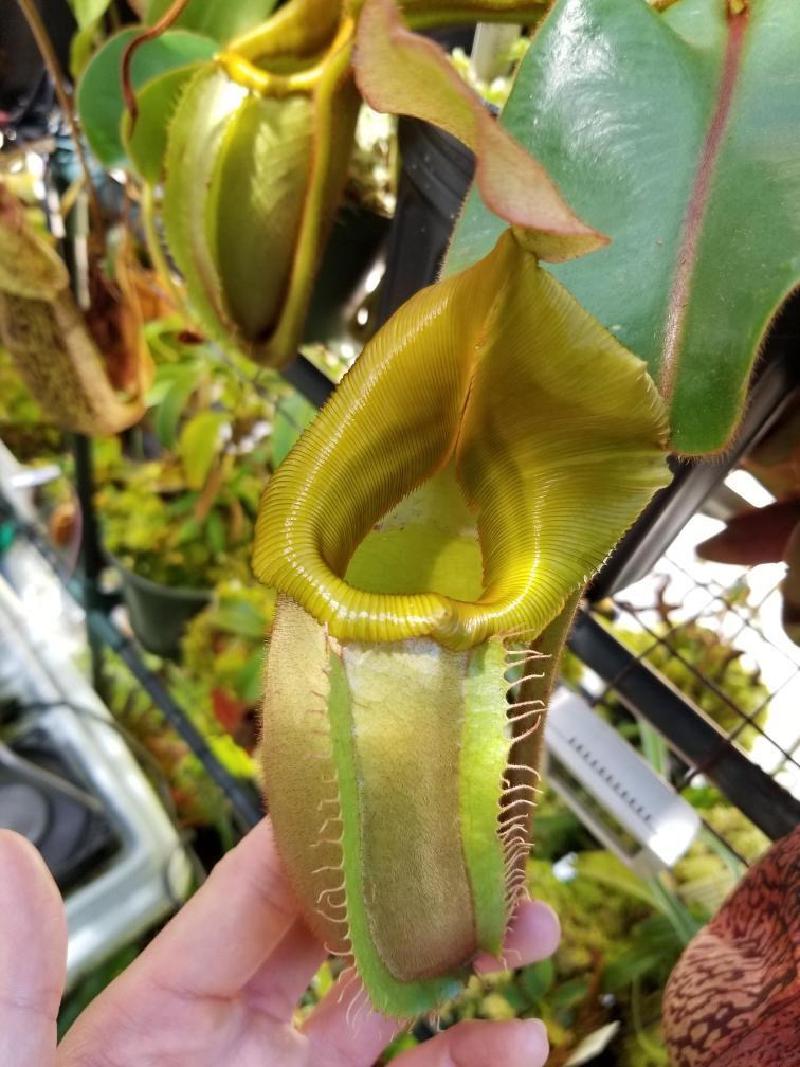 Nepenthes veitchii 'Batu Lawi' from Wistuba, grown by Francis Bauzon.
Nepenthes veitchii 'Batu Lawi' from Wistuba, grown by Francis Bauzon.
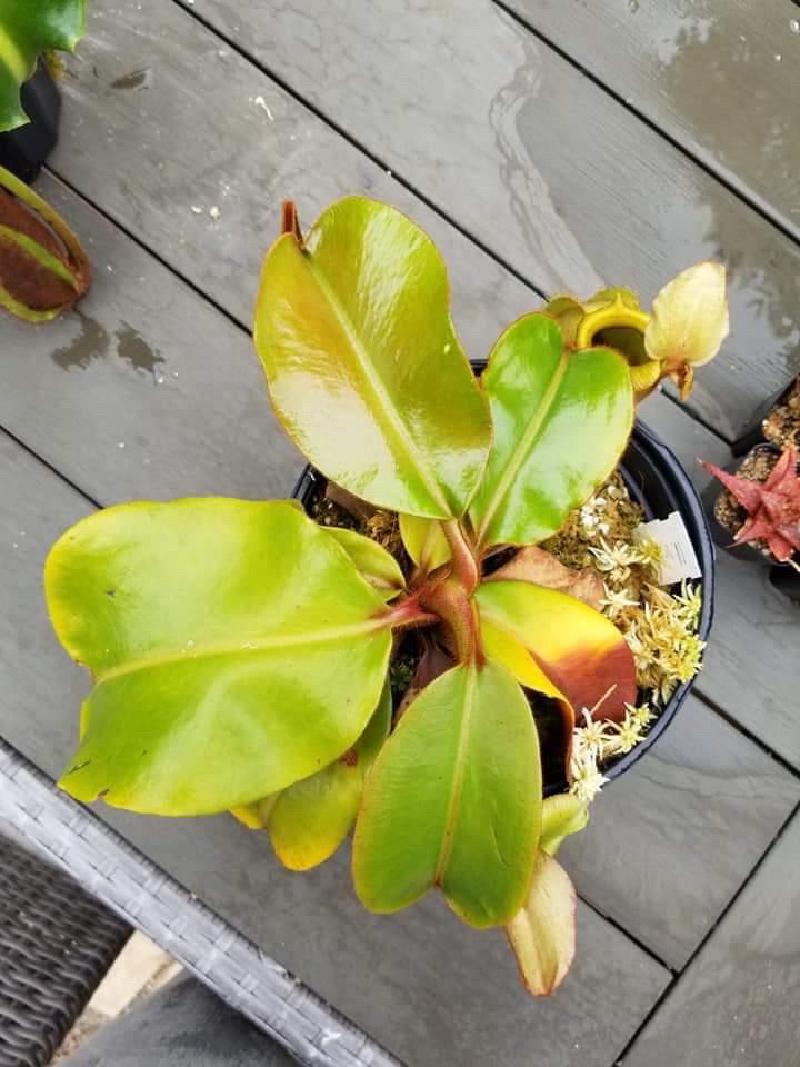 Nepenthes veitchii 'Batu Lawi' from Wistuba, grown by Francis Bauzon.
Nepenthes veitchii 'Batu Lawi' from Wistuba, grown by Francis Bauzon.
Are you breeding a Nepenthes veitchii grex and would like me to feature it here? Feel free to get in touch via email.
4. Hybridising N. veitchii
Nepenthes veitchii is a fantastic species to hybridise with. Its popularity as a hybrid parent dates back to the Victorian era, when George Tivey of Veitch Nurseries created Nepenthes x Tiveyi, a stunning cross between N. maxima (the seed parent) and N. veitchii.
When crossed with other species, N. veitchii often passes on temperature tolerance, a wide flared peristome, and attractive colouration to its offspring. Something I particularly like about N. veitchii as a parent is that its influence doesn’t tend to dominate the resulting hybrid, as I feel can happen with other species including N. hamata. Instead, you often end up with a very pleasing ‘intermediate’ look between the two parents.
Nepenthes veitchii features prominently in many popular complex hybrids, particularly those from Exotica Plants in Australia. Many are stunning, but if I were to try and document these we’d be here all day! As such, I’ve selected a small handful of photos below showcasing a few of my favourite primary crosses with N. veitchii.
If you grow a nice N. veitchii primary hybrid that you’d like me to feature here, please get in touch!
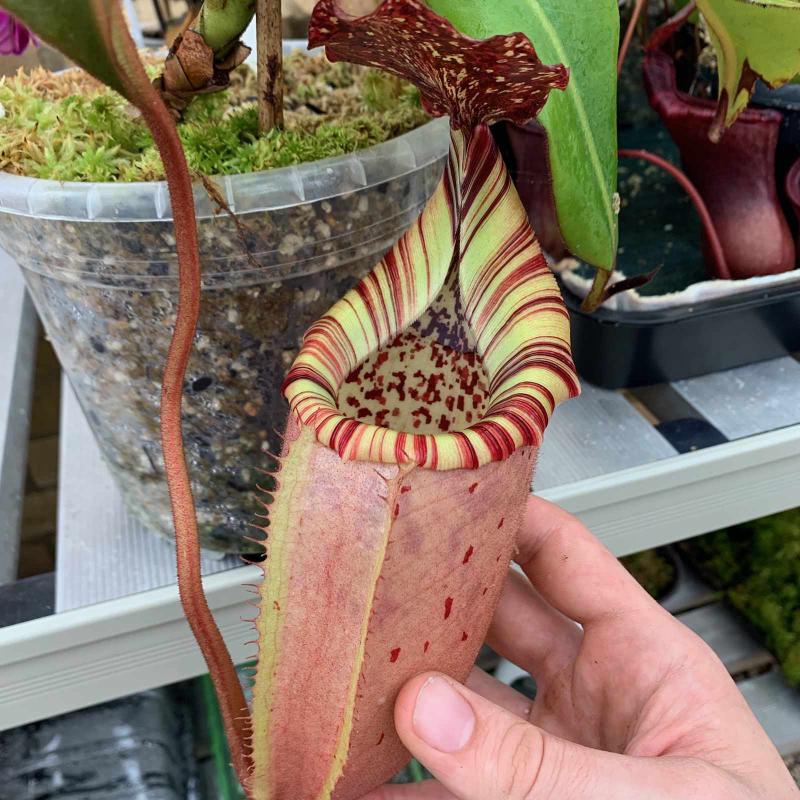 Nepenthes veitchii x burbidgeae (EP), grown by me.
Nepenthes veitchii x burbidgeae (EP), grown by me.
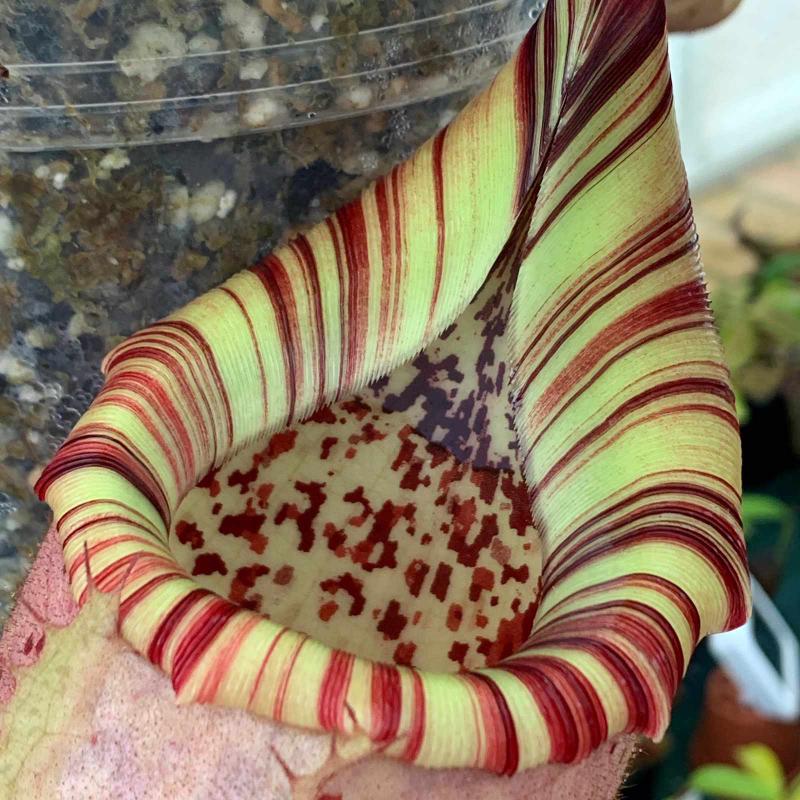 Incredible colour on the peristome of N. veitchii x burbidgeae (EP).
Incredible colour on the peristome of N. veitchii x burbidgeae (EP).
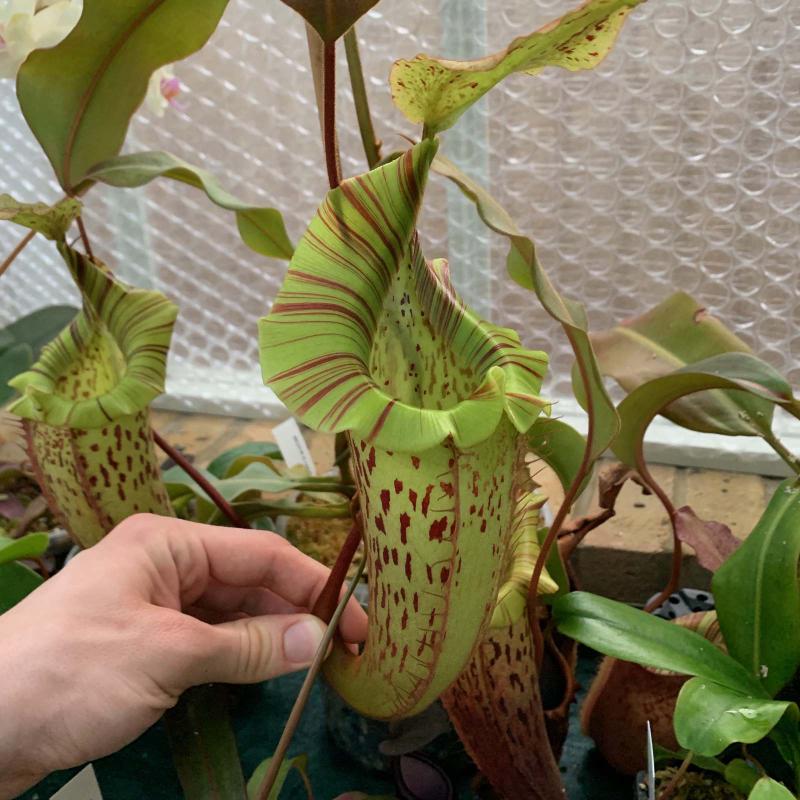 One of my favourite crosses in my whole collection, Nepenthes veitchii x platychila (BE 3213).
One of my favourite crosses in my whole collection, Nepenthes veitchii x platychila (BE 3213).
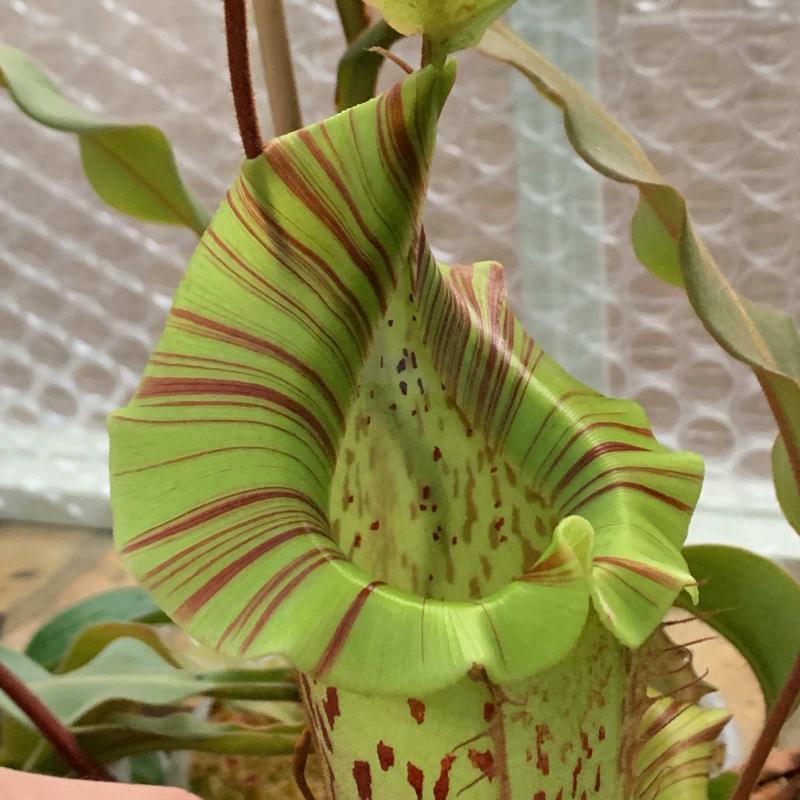 Close-up of N. veitchii x platychila. I've put loads of pics of this one on Instagram, because it's just so nice to look at!
Close-up of N. veitchii x platychila. I've put loads of pics of this one on Instagram, because it's just so nice to look at!
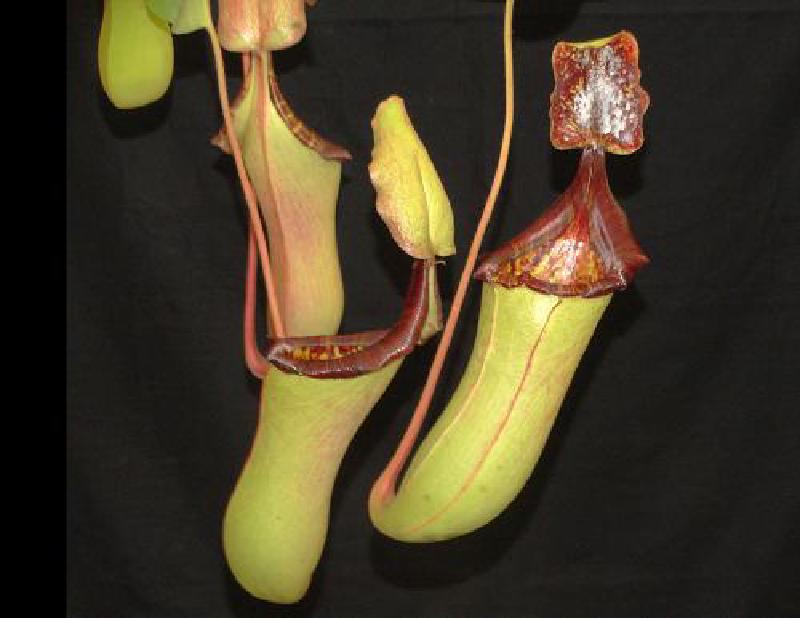 Nepenthes veitchii x lowii, from Borneo Exotics. Rob Cantley tells me it's the only plant to have caught rats in their nurseries, probably because it exudes nectar on the underside of the lid, a trait it has inherited from N. lowii.
Nepenthes veitchii x lowii, from Borneo Exotics. Rob Cantley tells me it's the only plant to have caught rats in their nurseries, probably because it exudes nectar on the underside of the lid, a trait it has inherited from N. lowii.
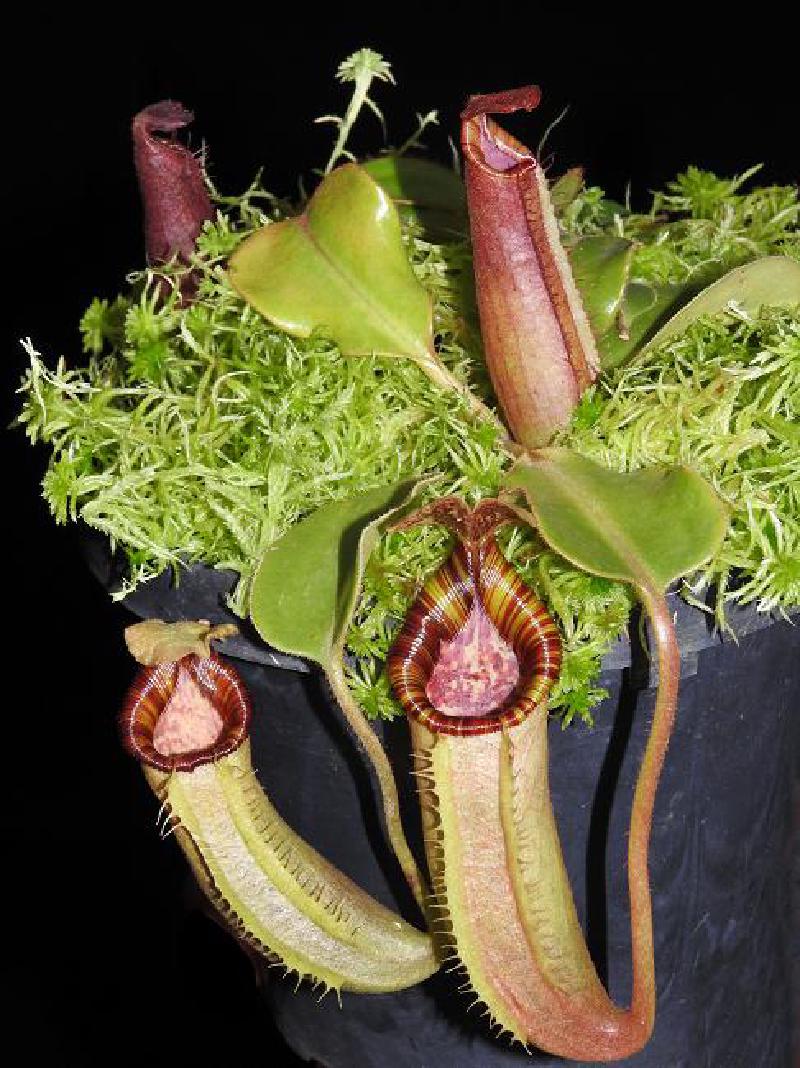 Juvenile pitchers on Borneo Exotics' new grex of N. veitchii x lowii (more accurately this is N. (veitchii x lowii) x (veitchii x lowii), a cross it has taken them 20 years to produce in the lab). This is BE-4006.
Juvenile pitchers on Borneo Exotics' new grex of N. veitchii x lowii (more accurately this is N. (veitchii x lowii) x (veitchii x lowii), a cross it has taken them 20 years to produce in the lab). This is BE-4006.
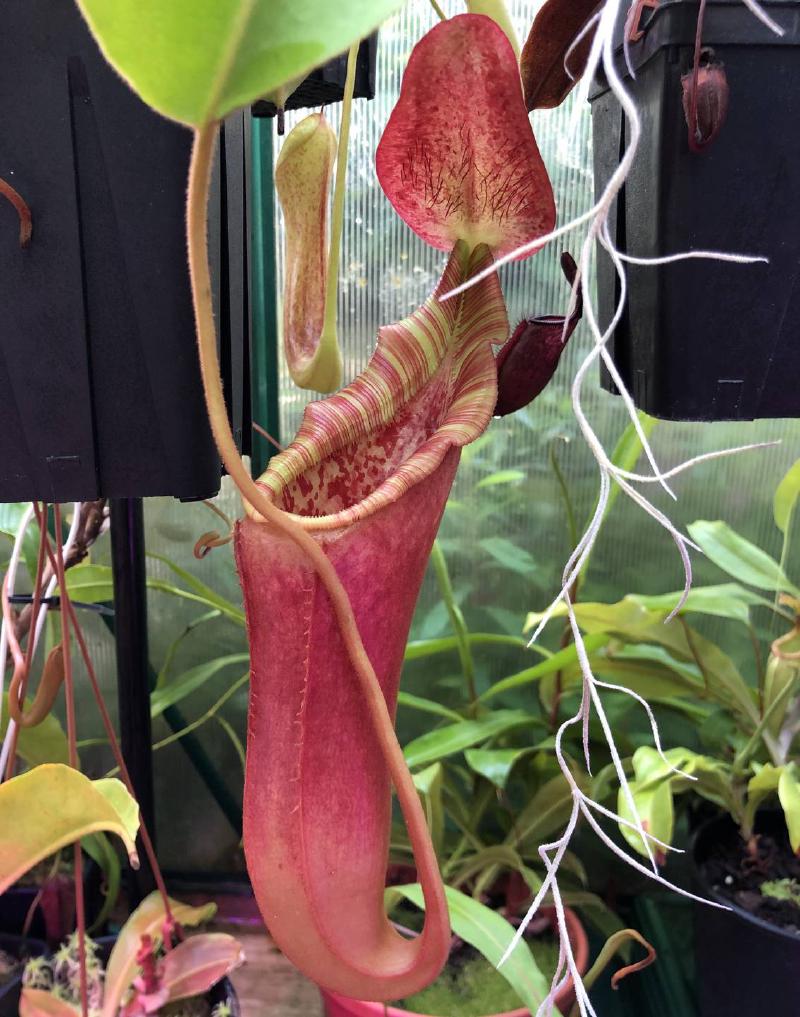 The reverse of the previous hybrid, this is Nepenthes lowii x veitchii, grown by David Durie.
The reverse of the previous hybrid, this is Nepenthes lowii x veitchii, grown by David Durie.
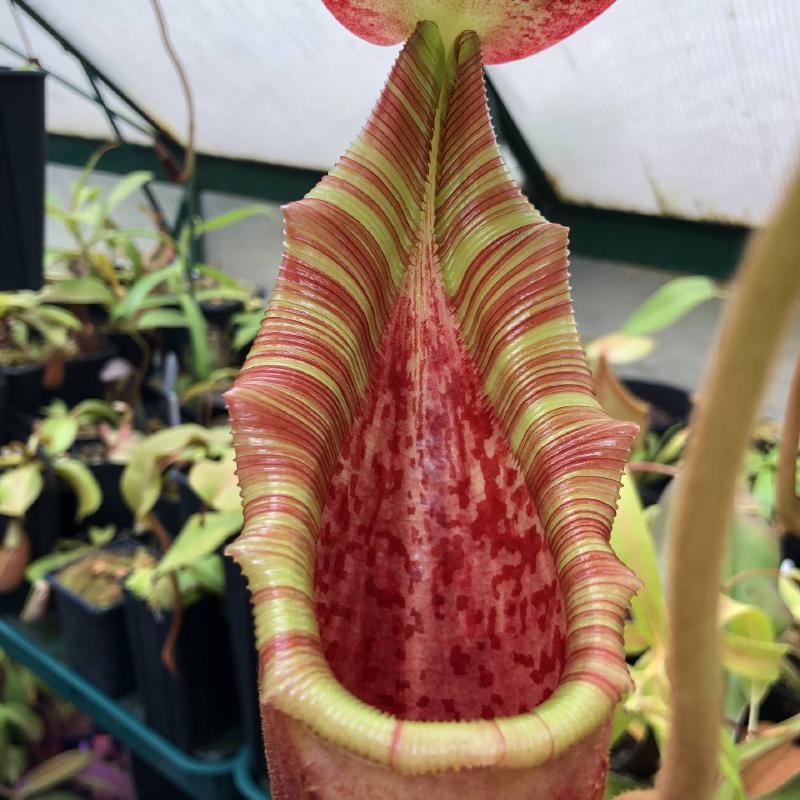 Nepenthes lowii x veitchii, grown by David Durie..
Nepenthes lowii x veitchii, grown by David Durie..
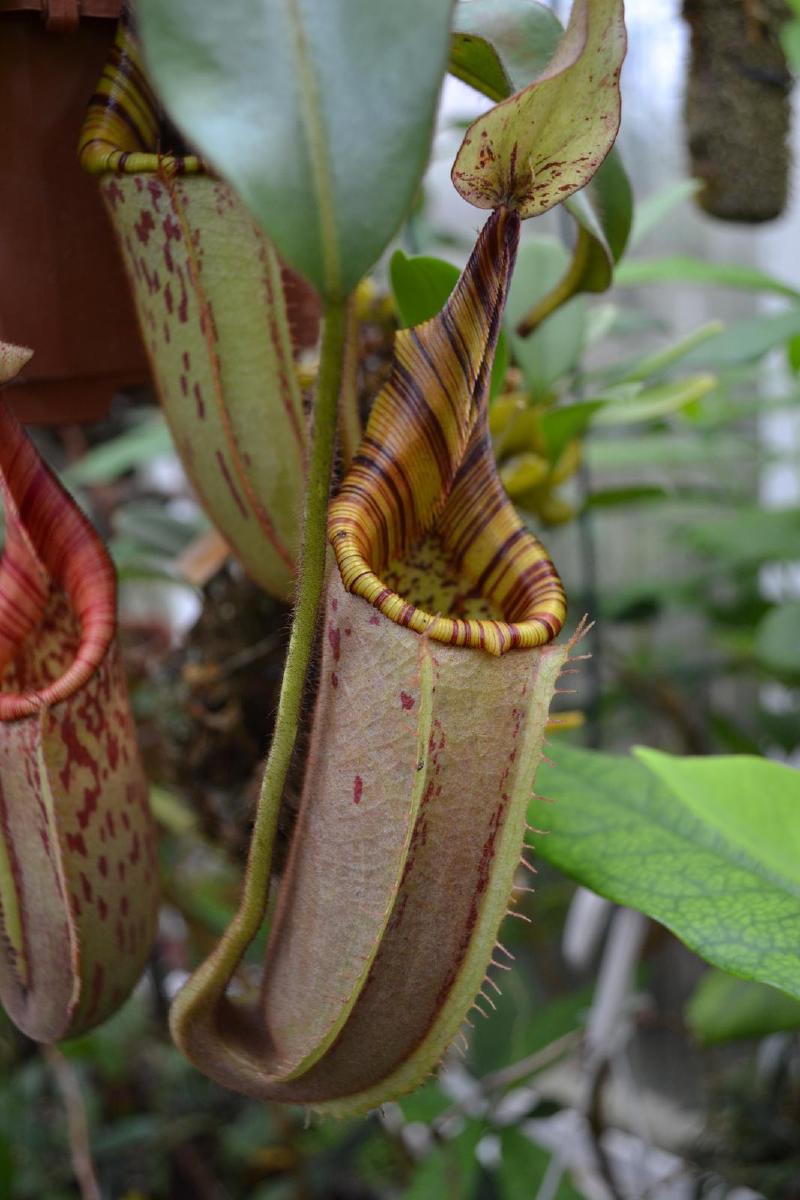 Nepenthes mollis × veitchii, formerly hurrelliana x veitchii, grown by Christian Klein.
Nepenthes mollis × veitchii, formerly hurrelliana x veitchii, grown by Christian Klein.
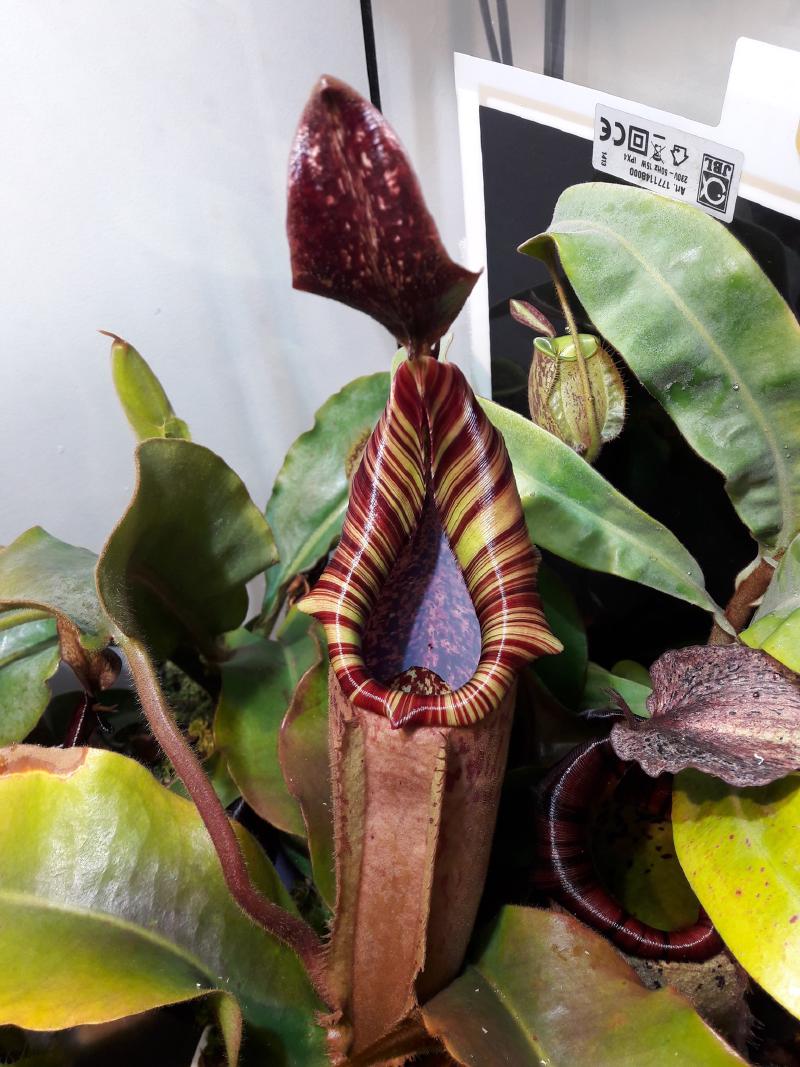 N. maxima 'wavy' x veitchii 'candy', a stunning recreation of N. Tiveyi grown by a friend of mine. I'll have some of these available in my Shop next month!
N. maxima 'wavy' x veitchii 'candy', a stunning recreation of N. Tiveyi grown by a friend of mine. I'll have some of these available in my Shop next month!
Thanks for reading! If you’d like to make a suggestion for a species (of any carnivorous genera) which you’d like to see featured on the blog, be sure to leave a comment below.
I've been growing carnivorous plants for over 2 decades, having been fascinated by these plants since I got my first Venus flytrap at age 10. I now have a large greenhouse to house my collection and am an avid breeder of Nepenthes pitcher plants.
- Next post: A visit to Jeremiah Harris, by David Görg
- Previous post: Electricity & gas: some tips on greenhouse heating

